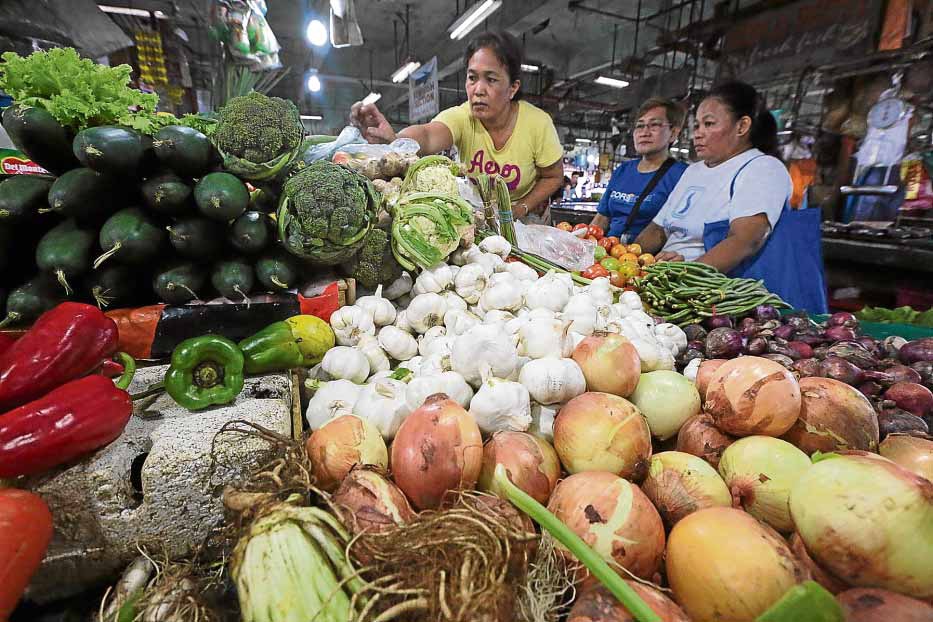
PRICE SPIKE With August inflation recorded at 6.4 percent, prices of vegetables and other food items have risen, like these sold at Commonwealth Market in Quezon City. —GRIG C. MONTEGRANDE
Prices of food, especially rice, fish, meat and vegetables, rose further in August, pushing inflation nationwide to 6.4 percent year-on-year, a nine-year high and prompting many consumers to find various ways to scrimp—from carpooling and bringing packed lunches to even forgoing dates on weekends.
Inflation was higher in Metro Manila at 7 percent, while price increases outside the metropolis averaged 6.2 percent, according to the Philippine Statistics Authority (PSA).
Hit hard by high inflation are the poor as food accounts for a big chunk of their income.
“This poses a serious threat to the food security of the bottom 30 percent of families in terms of income, who spend roughly P70 of every P100 they earn on food,” Sen. Sherwin Gatchalian said in a statement.
The inflation rates were higher than estimates of government and private sector economists, who had projected the nationwide rate to fall between 5.5 and 6.2 percent.
From January to August, inflation averaged 4.8 percent, above the government’s 2-4 percent target.
Even middle-class families are feeling the weight of high inflation.
Packed meals
Advertising manager Erick Listana used to have lunch in a restaurant or in the office canteen.
Listana now brings packed meals to work just to save money. He also had to cut down on some of his leisure activities, such as going to the movies on weekends.
He said he also had to add P2,000 to his family budget for groceries as the amount he was previously contributing was no longer enough.
To save on fuel expenses, accountant Aries Atienza and his colleagues have decided to carpool to work.
He noted, however, that his situation was not as bad as his brother’s, who had to figure out how he would be able to sell his produce given their high prices.
A small cabbage, he said, can now cost as much as P100 apiece.
Atienza said that to avoid incurring heavy losses, his brother would often cook the vegetables and sell them off as “pinakbet,” an Ilocano vegetable dish.
He pointed out though that selling the produce as viand still did not turn in a profit.
Food prices up 8.5%
In its report, the PSA noted that prices of food and nonalcoholic beverages rose 8.5 percent year-on-year.
The PSA also reported that prices of alcoholic beverages and tobacco jumped 21.6 percent.
Prices of furnishing, household equipment and routine maintenance of the house rose 3.5 percent; health and restaurant and miscellaneous goods and services, up 4 percent; and recreation and culture, up 2.4 percent.
“A big chunk of the August inflation rate is due to the rise in food prices—fish, rice, other meat and vegetables,” Budget Secretary Benjamin Diokno said on Wednesday.
Diokno said the four food items accounted for 38 percent (2.4 of the 6.4 percent) of the August inflation.
Rice prices, especially those of commercial varieties, surged last month in the wake of the depleted rice stock of the National Food Authority (NFA).
The NFA’s failure to perform its task of ensuring stable prices and supply of the staple has fueled calls for either the sacking of its administrator or its abolition.
Life harder for workers
At the Pasay public market, several kilometers from her boardinghouse, Nimfa Legaspi on Wednesday evening bought food for her and coworkers just “to save the smallest of my change.”
She touched each variety of rice at one of the stalls, but settled for 2 kilograms of La Rosa for P90 for their dinner and breakfast.
“This is not the variety that I often bought before. I could no longer afford Angelica or Jasmine (that cost at least P50 per kilo),” said the 54-year-old, who earns P512 daily, the minimum wage in Metro Manila.
She lamented that life was becoming more difficult.
Legaspi chose to leave her children in Batangas province to earn more while working at a construction site in Parañaque.
Asked what their viand at the boardinghouse would be, she said: “It should be meat but I can’t afford it. I might opt for fish but it might be also expensive.”
Legaspi pleaded with the Duterte administration to raise the wages of poor workers like her. “Everything now costs more. I hope our wages will also go up so our families will not go hungry.”
Self-inflicted
Albay Rep. Joey Salceda called the high inflation rate “self-inflicted” as the government “did little or nothing.”
What’s more worrisome is that rising prices would reverse gains in poverty reduction and hunger mitigation since the main culprit is food inflation.
Salceda called for the immediate adoption of measures to tame inflation, like higher NFA rice importation and targeted distribution to rice-deficit areas and food-deficit populations.
Rice tariffication
In a text message, Diokno said the August inflation called for a swift passage of the rice tariffication bill and faster delivery of the unconditional cash transfers.
President Rodrigo Duterte earlier certified the bill urgent to ensure its swift passage in Congress.
Speaker Gloria Macapagal-Arroyo said massive rice importation and the purchase of palay (unhusked rice) from local farmers could ease inflation like what she did in 2009.
George San Mateo, head of the transport group Piston, said jeepney drivers bore the burden of not only high inflation but also regressive taxes on oil products.
San Mateo lamented that despite the series of fare increase petitions, some of which have already been approved, drivers’ income continued to shrink amid rising prices of rice and other commodities. —With reports from Marlon Ramos, Leila B. Salaverria, Krixia Subingsubing, Darryl John Esguerra and Pathricia Ann V. Roxas